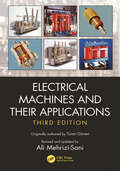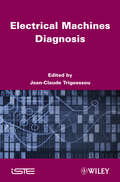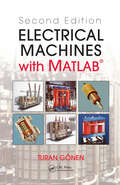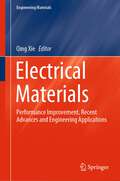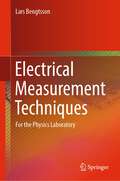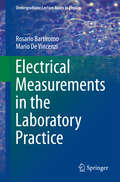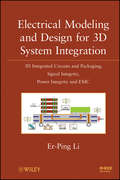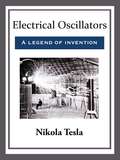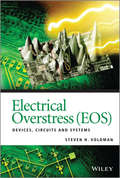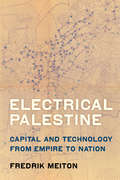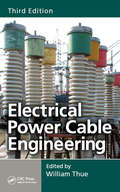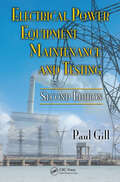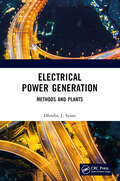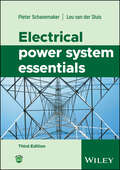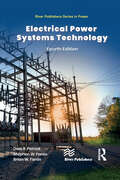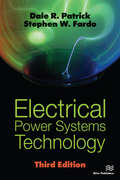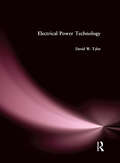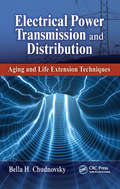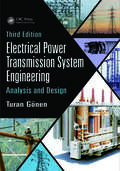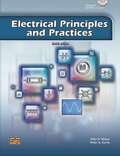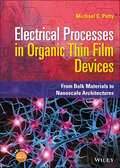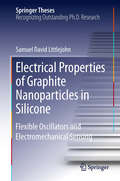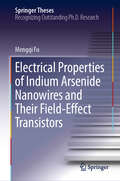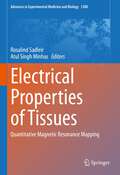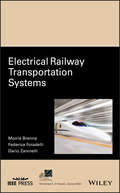- Table View
- List View
Electrical Machines and Their Applications
by Ali Mehrizi-SaniThis popular, easy-to-read book offers a comprehensive yet unique treatment of electrical machines and their historical development. Electrical Machines and Their Applications, Third Edition covers an in-depth analysis of machines augmented with ample examples, which makes it suitable for both those who are new to electric machines and for those who want to deepen their knowledge of electric machines. This book provides a thorough discussion of electrical machines. It starts by reviewing the basics of concepts needed to fully understand the machines, e.g., three-phase circuits and fundamentals of energy conversion, and continues to discuss transformers, induction machines, synchronous machines, dc machines, and other special machines and their dynamics. This natural progression creates a unifying theme and helps the reader appreciate how the same physical laws of energy conversion govern the operation and dynamics of different machine types. The text is sprinkled with ample examples to further solidify the discussed concepts. Several well-placed appendices make the book self-contained and even easier to follow. This book is part of a series on power system topics originally authored by the late Turan Gönen. The book has been edited by Ali Mehrizi-Sani to bring it up to date while maintaining its original charm. Both new and seasoned readers for Gönen’s books will find this new edition a much-awaited update to the second edition.
Electrical Machines Diagnosis
by Jean-Claude TrigeassouMonitoring and diagnosis of electrical machine faults is a scientific and economic issue which is motivated by objectives for reliability and serviceability in electrical drives. This book provides a survey of the techniques used to detect the faults occurring in electrical drives: electrical, thermal and mechanical faults of the electrical machine, faults of the static converter and faults of the energy storage unit. Diagnosis of faults occurring in electrical drives is an essential part of a global monitoring system used to improve reliability and serviceability. This diagnosis is performed with a large variety of techniques: parameter estimation, state observation, Kalman filtering, spectral analysis, neural networks, fuzzy logic, artificial intelligence, etc. Particular emphasis in this book is put on the modeling of the electrical machine in faulty situations. Electrical Machines Diagnosis presents original results obtained mainly by French researchers in different domains. It will be useful as a guideline for the conception of more robust electrical machines and indeed for engineers who have to monitor and maintain electrical drives. As the monitoring and diagnosis of electrical machines is still an open domain, this book will also be very useful to researchers.
Electrical Machines with MATLAB
by Turan GonenElectrical Machines with MATLAB encapsulates the invaluable insight and experience that eminent instructor Turan Gonen has acquired in almost 40 years of teaching. With simple, versatile content that separates it from other texts on electrical machines, this book is an ideal self-study tool for advanced students in electrical and other areas of eng
Electrical Materials: Performance Improvement, Recent Advances and Engineering Applications (Engineering Materials)
by Peng Wang Jun Xie Yiyi ZhangThis book highlights the latest advances in advanced insulating materials. Energy crisis and environmental pollution are two major themes currently faced by the human society. It is of unprecedented strategic importance to construct a strong smart grid with super/ultra-high voltage network as the backbone and clean energy transmission as the leading force. However, the performance of electrical equipment and devices is greatly determined by the properties of their insulating materials, especially when they have to work in extreme circumstances including high-temperature differences, intense radiation, and strong electric fields. The key advantage of polymers is that their properties could be adjusted by changing their chemical composition and molecular structure. Research on polymer insulating materials has been highly successful as progress has been made in characterizing these properties, designing molecular structures, and studying polymers’ specialized properties. On the other hand, nanodielectrics are prepared by adding certain nanoscale fillers into a polymer matrix to yield better electrical, thermal, and mechanical properties. When the particle pretreatment methods and the content or category of fillers are adjusted, nanodielectrics tend to have greater breakdown strength as well as better high-temperature resistance and space charge suppression. Therefore, this book covers investigations of properties of insulating materials that explore their interface effects and composite structures and introduces findings in methods that improve the performance of electrical devices. The book is not only used as a timely reference for engineering and technical personnel in related fields but also as a comprehensive textbook for college students.
Electrical Measurement Techniques: For the Physics Laboratory
by Lars BengtssonThis book highlights the electrical engineering aspects of a typical physics laboratory. To perform a sound experiment in a physics laboratory, it is paramount that readers understand the equipment and methods used to collect the data. This includes sensors (e.g., thermocouples and vacuum gauges), amplifiers (e.g., instrumentation amplifiers and lock-in amplifiers), oscilloscopes and probes (active probes and current probes), transmission cables (50-ohm termination) and noise shielding (grounding), spectrum analyzers (FFT and heterodyne technique), ADCs and digital signal processing, convolution and correlation, data analysis such as curve fitting, and uncertainty calculations (uncertainty ‘budgets’). The readers need to know about electromagnetic crosstalk, time-to-digital converters, student-t distributions, PID controllers, spectral leakage, and windows. This book helps readers understand all of that.
Electrical Measurements in the Laboratory Practice
by Rosario Bartiromo Mario De VincenziThis book covers thebasic theory of electrical circuits, describes analog and digitalinstrumentation, and applies modern methods to evaluate uncertainties in electricalmeasurements. It is comprehensive in scope and is designed specifically to meetthe needs of students in physics and electrical engineering who are attendinglaboratory classes in electrical measurements. The topics addressed inindividual chapters include the analysis of continuous current circuits;sources of measurement uncertainty and their combined effect; direct currentmeasurements; analysis of alternating current circuits; special circuitsincluding resonant circuits, frequency filters and impedance matchingnetworks; alternating current measurements; analog and digital oscilloscopes;non-sinusoidal waveforms and circuit excitation by pulses; distributedparameter components and transmission lines. Each chapter is equipped with anumber of problems. A special appendixdescribes a series of nine experiments, in each case providing a plan of actionfor students and guidance for tutors to assist in the preparation andillustration of the experiment.
Electrical Modeling and Design for 3D System Integration
by Er-Ping LiNew advanced modeling methods for simulating the electromagnetic properties of complex three-dimensional electronic systems Based on the author's extensive research, this book sets forth tested and proven electromagnetic modeling and simulation methods for analyzing signal and power integrity as well as electromagnetic interference in large complex electronic interconnects, multilayered package structures, integrated circuits, and printed circuit boards. Readers will discover the state of the technology in electronic package integration and printed circuit board simulation and modeling. In addition to popular full-wave electromagnetic computational methods, the book presents new, more sophisticated modeling methods, offering readers the most advanced tools for analyzing and designing large complex electronic structures. Electrical Modeling and Design for 3D System Integration begins with a comprehensive review of current modeling and simulation methods for signal integrity, power integrity, and electromagnetic compatibility. Next, the book guides readers through: The macromodeling technique used in the electrical and electromagnetic modeling and simulation of complex interconnects in three-dimensional integrated systems The semi-analytical scattering matrix method based on the N-body scattering theory for modeling of three-dimensional electronic package and multilayered printed circuit boards with multiple vias Two- and three-dimensional integral equation methods for the analysis of power distribution networks in three-dimensional package integrations The physics-based algorithm for extracting the equivalent circuit of a complex power distribution network in three-dimensional integrated systems and printed circuit boards An equivalent circuit model of through-silicon vias Metal-oxide-semiconductor capacitance effects of through-silicon vias Engineers, researchers, and students can turn to this book for the latest techniques and methods for the electrical modeling and design of electronic packaging, three-dimensional electronic integration, integrated circuits, and printed circuit boards.
Electrical Oscillators
by Nikola TeslaNikola Tesla was a genius who revolutionized how the world looks at electricity. In 1893 he patented an electro-mechanical oscillator as a steam-powered electric generator. By his own account, one version of the oscillator caused an earthquake in New York City in 1898, for which it was accorded the moniker, "Tesla's earthquake machine."
Electrical Overstress (EOS)
by Steven H. VoldmanElectrical Overstress (EOS) continues to impact semiconductor manufacturing, semiconductor components and systems as technologies scale from micro- to nano-electronics. This bookteaches the fundamentals of electrical overstress and how to minimize and mitigate EOS failures. The text provides a clear picture of EOS phenomena, EOS origins, EOS sources, EOS physics, EOS failure mechanisms, and EOS on-chip and system design. It provides an illuminating insight into the sources of EOS in manufacturing, integration of on-chip, and system level EOS protection networks, followed by examples in specific technologies, circuits, and chips. The book is unique in covering the EOS manufacturing issues from on-chip design and electronic design automation to factory-level EOS program management in today's modern world.Look inside for extensive coverage on:Fundamentals of electrical overstress, from EOS physics, EOS time scales, safe operating area (SOA), to physical models for EOS phenomenaEOS sources in today's semiconductor manufacturing environment, and EOS program management, handling and EOS auditing processing to avoid EOS failuresEOS failures in both semiconductor devices, circuits and systemDiscussion of how to distinguish between EOS events, and electrostatic discharge (ESD) events (e.g. such as human body model (HBM), charged device model (CDM), cable discharge events (CDM), charged board events (CBE), to system level IEC 61000-4-2 test events)EOS protection on-chip design practices and how they differ from ESD protection networks and solutionsDiscussion of EOS system level concerns in printed circuit boards (PCB), and manufacturing equipmentExamples of EOS issues in state-of-the-art digital, analog and power technologies including CMOS, LDMOS, and BCDEOS design rule checking (DRC), LVS, and ERC electronic design automation (EDA) and how it is distinct from ESD EDA systemsEOS testing and qualification techniques, andPractical off-chip ESD protection and system level solutions to provide more robust systemsElectrical Overstress (EOS): Devices, Circuits and Systems is a continuation of the author's series of books on ESD protection. It is an essential reference and a useful insight into the issues that confront modern technology as we enter the nano-electronic era.
Electrical Palestine: Capital and Technology from Empire to Nation
by Fredrik MeitonElectricity is an integral part of everyday life—so integral that we rarely think of it as political. In Electrical Palestine, Fredrik Meiton illustrates how political power, just like electrical power, moves through physical materials whose properties govern its flow. At the dawn of the Arab-Israeli conflict, both kinds of power were circulated through the electric grid that was built by the Zionist engineer Pinhas Rutenberg in the period of British rule from 1917 to 1948. Drawing on new sources in Arabic, Hebrew, and several European languages, Electrical Palestine charts a story of rapid and uneven development that was greatly influenced by the electric grid and set the stage for the conflict between Arabs and Jews. Electrification, Meiton shows, was a critical element of Zionist state building. The outcome in 1948, therefore, of Jewish statehood and Palestinian statelessness was the result of a logic that was profoundly conditioned by the power system, a logic that has continued to shape the area until today.
Electrical Power Cable Engineering: Second: Edition, (Power Engineering (Willis) #1)
by William ThueFully updated, Electrical Power Cable Engineering, Third Edition again concentrates on the remarkably complex design, application, and preparation methods required to terminate and splice cables. This latest addition to the CRC Press Power Engineering series covers cutting-edge methods for design, manufacture, installation, operation, and maintenance of reliable power cable systems. It is based largely on feedback from experienced university lecturers who have taught courses on these very concepts. The book emphasizes methods to optimize vital design and installation of power cables used in the interrelated fields of electrical, mechanical, and, to some extent, civil engineering. An in-depth exploration of power cable characteristics and applications, it illustrates the many factors that can hinder real-world cable performance. Content focuses on low and medium voltages, considering that these are used for the majority of cables in service globally. This edition also details techniques for testing shielded power cable systems in the field, demonstrating how conductor material size and design depend on ampacity, voltage regulation, and other factors. Covering everything from manufacturing to testing, this resource will benefit: Cable engineers and technicians (working for investor-owned utilities, rural electric cooperatives, and industrial manufacturers) who need to improve their oversight and understanding of power cables Universities that offer electrical power courses Professionals who must master new power cable terminology, engineering characteristics, and background information that will aid them in their decision making responsibilities The author is a life fellow of the IEEE and one of the original developers of industry standards for cables and accessories. To simplify field fundamentals and techniques for less experienced readers, his book contains new, updated, and expanded chapters and an extensive glossary, in addition to useful references, tables, equations, and photographs. More experienced engineers will appreciate the book’s invaluable updates on the emerging materials, products, and concepts driving their dynamic field.
Electrical Power Equipment Maintenance and Testing (Second Edition)
by Paul GillThe second edition of a bestseller, this definitive text covers all aspects of testing and maintenance of the equipment found in electrical power systems serving industrial, commercial, utility substations, and generating plants. It addresses practical aspects of routing testing and maintenance and presents both the methodologies and engineering basics needed to carry out these tasks. It is an essential reference for engineers and technicians responsible for the operation, maintenance, and testing of power system equipment. Comprehensive coverage includes dielectric theory, dissolved gas analysis, cable fault locating, ground resistance measurements, and power factor, dissipation factor, DC, breaker, and relay testing methods.
Electrical Power Generation: Methods and Plants
by Dhruba J. SyamIn today’s world, per capita consumption of electricity in a country is considered as one of the important indices of its developmental status: both economic and technological. Engineering students as well as the professional beginners, studying and working in the field of Electrical Power Generation and Power Plant Administration, should get a reasonable level of familiarization with the concepts of various technological methods and plants in order to acquire necessary knowledge and competency for a worthwhile professional career in the subject field. This book attempts to provide relevant knowledge inputs by way of providing conceptual clarity on various aspects of the subject. It will be helpful for students of Electrical and Mechanical Engineering. Print edition not for sale in South Asia (India, Sri Lanka, Nepal, Bangladesh, Pakistan and Bhutan)
Electrical Power System Essentials
by Pieter Schavemaker Lou van der SluisA highly accessible resource covering the basics of the design and operation of electrical power systems with minimal technical background required Electrical Power System Essentials delivers a thorough introduction to the electrical power system and its functioning, and the changes that come with the worldwide energy transition process. This revised and updated Third Edition includes new material on HVDC developments, electricity markets, capacity calculation (NTC and flow-based), power system protection, and energy storage. Discussions on how renewable sources play a more dominant role in the generation of electrical energy and the effects they have on the control and operation of the grid and electricity markets are also included. Written in the accessible style that has made previous editions so popular with readers, this book restricts math content to the Appendix in order to maintain an easy reading experience of the main text while still providing complete coverage. A companion website includes downloadable teaching materials, and accessory videos are viewable on the Wiley website (www.wiley.com/go/powersystem3e) and YouTube (https://www.youtube.com/playlist?list=PLvaU1SY38TUV8JTwkf1taN-w_bQbCD0Ad). Topics discussed in the book include: Generation of electric energy, covering nuclear fission, wind energy and wind turbine concepts, hydropower and pumped storage, and solar powerElectricity markets, covering gas scarcity, its influence on the marginal price of electricity, and negative energy pricesFuture power systems, covering higher harmonics, increased use of cables instead of overhead transmission lines, distributed generation and power-electronic interfacesTransmission of electric energy, covering DC circuit breakers, wide area measurement systems, and distribution networks Electrical Power System Essentials is a perfect textbook for second- and third-year undergraduate electrical engineering students who need an accessible course text introducing concepts in power system engineering. The text is also valuable for other students and professionals who require an up-to-date reference on power systems technology.
Electrical Power Systems Technology
by Dale R. Patrick Stephen W. Fardo Brian W. FardoElectrical Power Systems Technology, Fourth Edition covers a wide range of technologies and systems used in the generation, distribution, control, conversion, and measurement of electrical power. This reference book provides a foundational overview presented in a basic, easy-to-understand manner. The content is organized in a logical pedagogical style using five basic power system components – Measurement, Generation, Distribution, Control, and Conversion. Each of these basic systems is broken down into sub-systems, equipment, and components that are explored in greater detail in each of the 18 chapters. Simplified mathematical concepts are described with practical applications to assist in fundamental understanding. Abundant illustrations (almost one per page) are used to add visual information to supplement technical knowledge development. The fourth edition has been edited to provide improved information and clarity, including many new illustrations. An additional chapter – Chapter 18 – Evolving Power System Technologies and Considerations – has been added to describe issues related to power system operation.
Electrical Power Systems Technology, Third Edition
by Stephen W. Fardo Dale R. PatrickCovering the gamut of technologies and systems used in the generation of electrical power, this reference provides an easy-to understand overview of the production, distribution, control, conversion, and measurement of electrical power. The content is presented in an easy to understand style, so that readers can develop a basic comprehensive understanding of the many parts of complex electrical power systems. The authors describe a broad array of essential characteristics of electrical power systems from power production to its conversion to another form of energy. Each system is broken down into sub systems and equipment that are further explored in the chapters of each unit. Simple mathematical presentations are used with practical applications to provide an easier understanding of basic power system operation. Many illustrations are included to facilitate understanding. This new third edition has been edited throughout to assure its content and illustration clarity, and a new chapter covering control devises for power control has been added.
Electrical Power Technology
by D TylerThis book is a comprehensive introductory text on electrical power, encompassing generation, electrical machines, motors, electrical materials, etc. David Tyler's approach is designed for independent or classroom study, with plenty of learning checks and activities throughout. The content is designed to cover Advanced GNVQ and BTEC NII syllabuses, but it is also ideal as an introduction for first year degree students or for professionals seeking to reinforce their grasp of the fundamentals.
Electrical Power Transmission and Distribution: Aging and Life Extension Techniques
by Bella H. ChudnovskyElectrical distribution and transmission systems are complex combinations of various conductive and insulating materials. When exposed to atmospheric corrosive gases, contaminants, extreme temperatures, vibrations, and other internal and external impacts, these systems deteriorate, and sooner or later their ability to function properly is destroyed. Electrical Power Transmission and Distribution: Aging and Life Extension Techniques offers practical guidance on ways to slow down the aging of these electrical systems, improve their performance, and extend their life. Recognize the Signs of Aging in Equipment—and Learn How to Slow It A reference manual for engineering, maintenance, and training personnel, this book analyzes the factors that cause materials to deteriorate and explains what you can do to reduce the impact of these factors. In one volume, it brings together extensive information previously scattered among manufacturers’ documentation, journal papers, conference proceedings, and general books on plating, lubrication, insulation, and other areas. Shows you how to identify the signs of equipment aging Helps you understand the causes of equipment deterioration Suggests practical techniques for protecting electrical apparatus from deterioration and damage Supplies information that can be used to develop manuals on proper maintenance procedures and choice of materials Provides numerous examples from industry This book combines research and engineering material with maintenance recommendations given in layperson’s terms, making it useful for readers from a range of backgrounds. In particular, it is a valuable resource for personnel responsible for the utilization, operation, and maintenance of electrical transmission and distribution equipment at power plants and industrial facilities.
Electrical Power Transmission System Engineering: Analysis and Design, Third Edition
by Turan GonenElectrical Power Transmission System Engineering: Analysis and Design is devoted to the exploration and explanation of modern power transmission engineering theory and practice. Designed for senior-level undergraduate and beginning-level graduate students, the book serves as a text for a two-semester course or, by judicious selection, the material
Electrical Principles and Practices
by Glen MazurThis textbook explains residential, commercial, and industrial applications of electrical and electronic principles. Content includes NFPA 70E® arc blast and arc flash requirements, portable generator sizing, power optimization, utility power factor and peak demand penalty, load shedding, power factor correction, smart grid and smart appliance technology, and wireless speakers.
Electrical Processes in Organic Thin Film Devices: From Bulk Materials to Nanoscale Architectures
by Michael C. PettyElectrical Processes in Organic Thin Film Devices A one-stop examination of fundamental electrical behaviour in organic electronic device architectures In Electrical Processes in Organic Thin Film Devices: From Bulk Materials to Nanoscale Architectures, distinguished researcher Michael C. Petty delivers an in-depth treatment of the electrical behaviour of organic electronic devices focused on first principles. The author describes the fundamental electrical behaviour of various device architectures and offers an introduction to the physical processes that play a role in the electrical conductivity of organic materials. Beginning with band theory, the text moves on to address the effects of thin film device architectures and nanostructures. The book discusses the applications to devices currently in the marketplace, like displays, as well as those under development (transistors, solar cells, and memories). Electrical Processes in Organic Thin Film Devices also describes emerging organic thin film architectures and explores the potential for single molecule electronics and biologically inspired devices. Finally, the book also includes: A detailed introduction to electronic and vibrational states in organic solids, including classical band theory, disordered semiconductors, and lattice vibrations Comprehensive explorations of electrical conductivity, including electronic and ionic processes, carrier drift, diffusion, the Boltzmann Transport Equation, excess carriers, recombination, doping, and superconductivity An overview of important electro-active organic materials, like molecular crystals, charge-transfer complexes, conductive polymers, carbon nanotubes, and graphene Practical considerations of defects and nanoscale phenomena, including transport processes in low-dimensional systems, surfaces and interface states In-depth examinations of metal contacts, including ohmic contacts, the Schottky Barrier, and metal/molecule contacts A systematic guide to the operating principles of metal/insulator/semiconductor structures and the field effect A set of problems (with solutions on-line) for each chapter of the book Perfect for electronics developers and researchers in both industry and academia who study and work with molecular and nanoscale electronics, Electrical Processes in Organic Thin Film Devices also deserves a place in the libraries of undergraduate and postgraduate students in courses on molecular electronics, organic electronics, and plastic electronics.
Electrical Properties of Graphite Nanoparticles in Silicone: Flexible Oscillators and Electromechanical Sensing
by Samuel David LittlejohnThis thesis examines a novel class of flexible electronic material with great potential for use in the construction of stretchable amplifiers and memory elements. Most remarkably the composite material produces spontaneous oscillations that increase in frequency when pressure is applied to it. In this way, the material mimics the excitatory response of pressure-sensing neurons in the human skin. The composites, formed of silicone and graphitic nanoparticles, were prepared in several allotropic forms and functionalized with naphthalene diimide molecules. A systematic study is presented of the negative differential resistance (NDR) region of the current-voltage curves, which is responsible for the material's active properties. This study was conducted as a function of temperature, graphite filling fraction, scaling to reveal the break-up of the samples into electric field domains at the onset of the NDR region, and an electric-field induced metal-insulator transition in graphite nanoparticles. The effect of molecular functionalization on the miscibility threshold and the current-voltage curves is demonstrated. Room-temperature and low-temperature measurements were performed on these composite films under strains using a remote-controlled, custom-made step motor bench.
Electrical Properties of Indium Arsenide Nanowires and Their Field-Effect Transistors (Springer Theses)
by Mengqi FuThis book explores the impacts of important material parameters on the electrical properties of indium arsenide (InAs) nanowires, which offer a promising channel material for low-power electronic devices due to their small bandgap and high electron mobility. Smaller diameter nanowires are needed in order to scale down electronic devices and improve their performance. However, to date the properties of thin InAs nanowires and their sensitivity to various factors were not known. The book presents the first study of ultrathin InAs nanowires with diameters below 10 nm are studied, for the first time, establishing the channel in field-effect transistors (FETs) and the correlation between nanowire diameter and device performance. Moreover, it develops a novel method for directly correlating the atomic-level structure with the properties of individual nanowires and their device performance. Using this method, the electronic properties of InAs nanowires and the performance of the FETs they are used in are found to change with the crystal phases (wurtzite, zinc-blend or a mix phase), the axis direction and the growth method. These findings deepen our understanding of InAs nanowires and provide a potential way to tailor device performance by controlling the relevant parameters of the nanowires and devices.
Electrical Properties of Tissues: Quantitative Magnetic Resonance Mapping (Advances in Experimental Medicine and Biology #1380)
by Rosalind Sadleir Atul Singh MinhasThis book covers the latest developments in tissue electrical conductivity and current density imaging, increasingly popular as well as challenging applications of MRI. These applications are enabled by the acquisition of high-quality MR phase images. This book provides a practical description of the MRI physics needed to understand and acquire phase images in MRI and the key details required to reconstruct them into conductivity, current density or electric field distributions. Comprehensive details are provided about the electrical properties of biological tissues, computational modeling considerations, experimental methods, construction of non-biological and biological phantoms and MRI pulse sequences. An inclusive review of image reconstruction algorithms, and their potential applications is provided for applications directed at determining current density or electric fields, such as in transcranial DC or AC stimulation techniques; as well as electrical conductivity reconstructions that may be of use in quantitative MRI applications used to detect cancer or other pathologies. This is an excellent book for undergraduate and graduate students beginning to explore phase, current density, and conductivity imaging in MRI, and will also be of great use to researchers interested in the area of MR-based electrical property imaging.
Electrical Railway Transportation Systems (IEEE Press Series on Power Engineering)
by Morris Brenna Federica Foiadelli Dario ZaninelliAllows the reader to deepen their understanding of various technologies for both fixed power supply installations of railway systems and for railway rolling stock This book explores the electric railway systems that play a crucial role in the mitigation of congestion and pollution caused by road traffic. It is divided into two parts: the first covering fixed power supply systems, and the second concerning the systems for railway rolling stock. In particular, after a historical introduction to the framework of technological solutions in current use, the authors investigate electrification systems for the power supply of rail vehicles, trams, and subways. Electrical Railway Transportation Systems explores the direct current systems used throughout the world for urban and suburban transport, which are also used in various countries for regional transport. It provides a study of alternating current systems, whether for power supply frequency or for special railway frequency, that are used around the world for the electrification of railway lines, long-distance lines, and high-speed lines. In addition, this resource: Analyzes multiple railway systems from a theoretical and realizable vantage point, with particular regard to functionality, electromagnetic compatibility, and interferences with other electrical systems Studies electric traction railway vehicles, presenting various types of drives and auxiliary devices currently in circulation Discusses solutions employed to ensure interoperability of vehicles that run along lines powered by different systems (e.g., DC and AC, at different frequencies) Electrical Railway Transportation Systems is an ideal text for graduate students studying the subject as well as for industry professionals working in the field.
